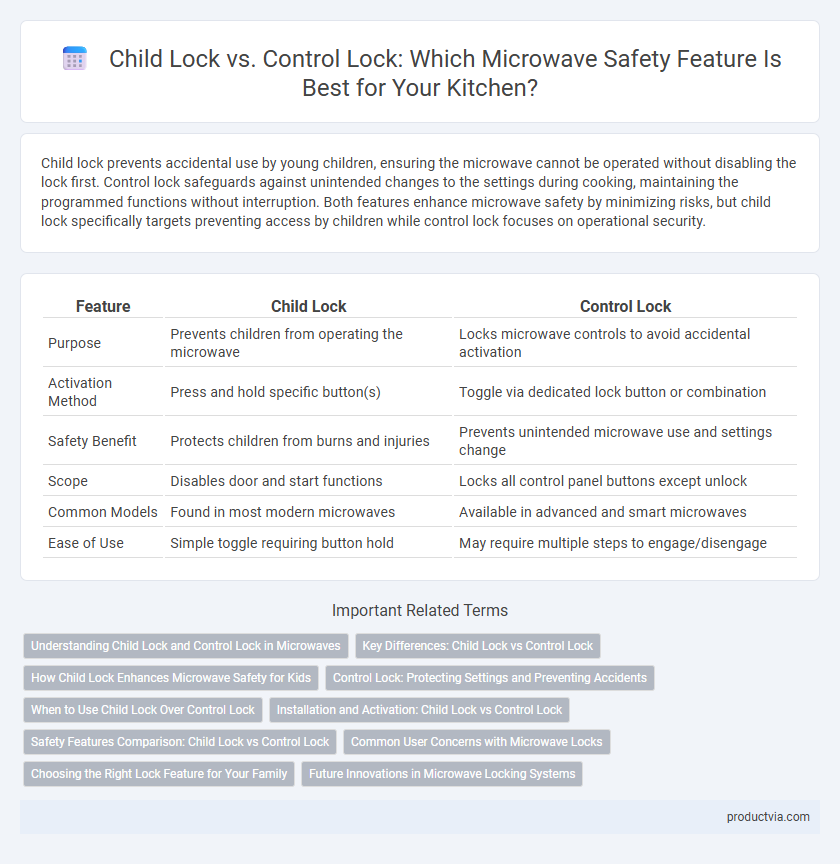Child lock prevents accidental use by young children, ensuring the microwave cannot be operated without disabling the lock first. Control lock safeguards against unintended changes to the settings during cooking, maintaining the programmed functions without interruption. Both features enhance microwave safety by minimizing risks, but child lock specifically targets preventing access by children while control lock focuses on operational security.
Table of Comparison
| Feature | Child Lock | Control Lock |
|---|---|---|
| Purpose | Prevents children from operating the microwave | Locks microwave controls to avoid accidental activation |
| Activation Method | Press and hold specific button(s) | Toggle via dedicated lock button or combination |
| Safety Benefit | Protects children from burns and injuries | Prevents unintended microwave use and settings change |
| Scope | Disables door and start functions | Locks all control panel buttons except unlock |
| Common Models | Found in most modern microwaves | Available in advanced and smart microwaves |
| Ease of Use | Simple toggle requiring button hold | May require multiple steps to engage/disengage |
Understanding Child Lock and Control Lock in Microwaves
Child lock in microwaves is a safety feature designed to prevent children from accidentally starting or altering microwave settings, ensuring the device remains inactive unless intentionally unlocked. Control lock, on the other hand, disables the entire control panel to avoid unintentional operations or changes by any user, offering broader protection during cleaning or when the microwave is not in use. Both locks enhance safety but serve distinct purposes: child lock specifically targets child safety, while control lock provides overall control panel security.
Key Differences: Child Lock vs Control Lock
Child lock on microwaves is designed specifically to prevent children from operating the appliance, disabling the control panel to avoid accidental use. Control lock, on the other hand, restricts all user inputs temporarily to prevent unintended settings changes, often used by all household members for safety and convenience. The key difference lies in their intent: child lock targets child safety, while control lock serves broader operational security and prevention of misuse.
How Child Lock Enhances Microwave Safety for Kids
Child lock enhances microwave safety by preventing children from accidentally starting or altering the cooking process, reducing the risk of burns or injuries. This feature disables the keypad or control panel, ensuring kids cannot operate the microwave without adult supervision. Unlike control lock, which may only restrict certain functions, child lock specifically targets safety for young users by fully locking the appliance's controls.
Control Lock: Protecting Settings and Preventing Accidents
Control lock on microwave ovens secures all functional settings, preventing unintended changes and enhancing safety, especially in households with children or elderly users. Unlike child lock, which primarily restricts door operation, control lock disables the keypad, safeguarding programmed cooking cycles and reducing the risk of accidental activation. This feature is vital for maintaining consistent microwave performance while minimizing potential hazards associated with accidental presses.
When to Use Child Lock Over Control Lock
Child lock is essential for households with young children, preventing accidental microwave operation and reducing the risk of burns or injuries. Control lock, on the other hand, is designed to disable all control panel functions, ideal for cleaning or temporarily disabling the microwave without causing safety hazards. Use child lock to ensure safer kitchen environments when children are present, whereas control lock is best for maintenance or preventing unintended settings changes.
Installation and Activation: Child Lock vs Control Lock
Child lock and control lock features both enhance microwave safety by preventing unintended operation, but their installation and activation methods differ. Child lock typically involves pressing and holding specific buttons for a few seconds to activate or deactivate, designed to be straightforward for parents. Control lock, often integrated within the microwave's control panel settings, may require navigating a menu or combination of button presses, providing a more comprehensive locking mechanism for all functions beyond just the keypad.
Safety Features Comparison: Child Lock vs Control Lock
Child lock in microwaves is specifically designed to prevent children from operating the appliance, ensuring safety by disabling all key functions except the power off button. Control lock, by contrast, secures the entire control panel to prevent accidental changes or misuse by anyone, providing broader protection against unintended microwave operation. Both features enhance safety, but child lock targets child-proofing while control lock offers comprehensive control panel security.
Common User Concerns with Microwave Locks
Child lock and control lock features in microwaves address common user concerns about accidental operation and safety hazards. Child lock prevents unintended use by disabling the keypad, ensuring that children cannot start or alter cooking settings, while control lock secures the entire control panel against any inputs, offering broader protection from accidental changes. Users often prioritize these locks to avoid burns, spills, and electrical accidents, enhancing overall kitchen safety.
Choosing the Right Lock Feature for Your Family
Child lock on microwaves prevents unintended use by disabling door operation or control panel functions, ensuring safety for young children. Control lock restricts access to the microwave's settings and buttons, protecting against accidental changes or misuse by all users. Selecting the appropriate lock feature depends on your family's needs; child lock is ideal for homes with toddlers, while control lock offers broader protection for households wanting to avoid accidental operation.
Future Innovations in Microwave Locking Systems
Future innovations in microwave locking systems emphasize enhanced child lock and control lock technologies integrating biometric authentication and AI-driven safety protocols to prevent accidental operation. Advanced sensors and machine learning algorithms improve the precision of control locks, ensuring authorized usage while maintaining convenience. These developments aim to create smarter, safer microwaves that adapt to user habits and provide customizable security options.
Child lock vs Control lock for microwave safety Infographic

 productvia.com
productvia.com